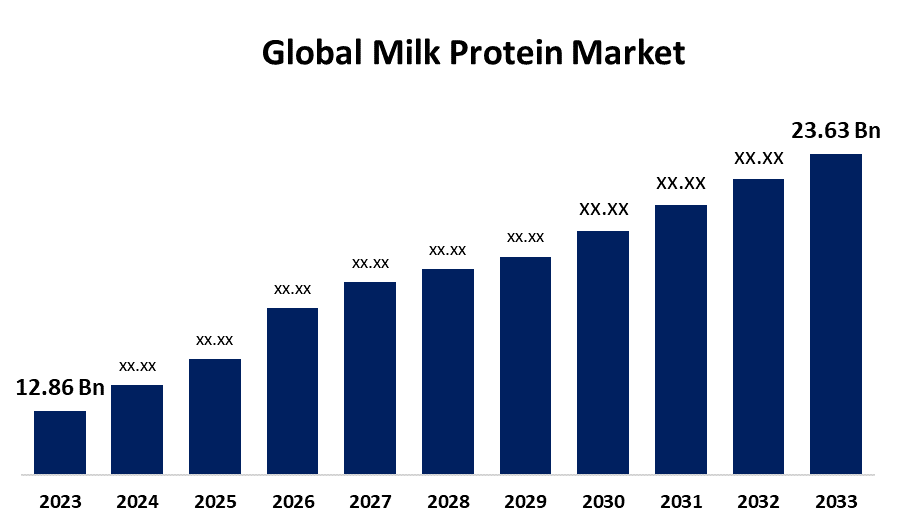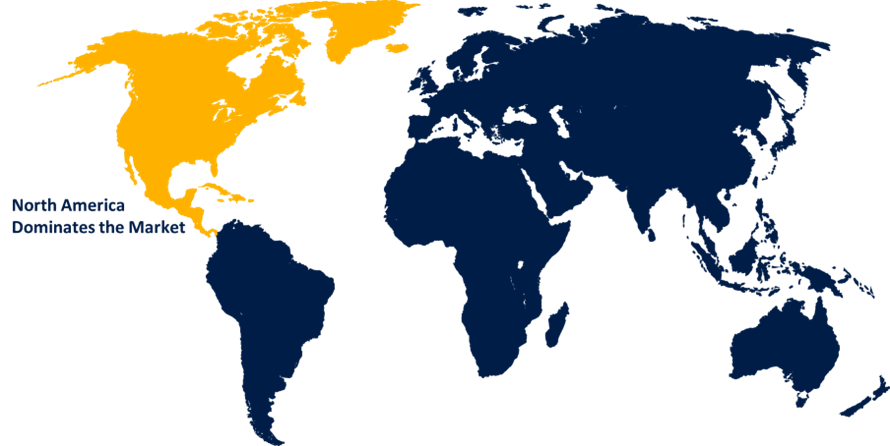Global Milk Protein Market Size, Share, and COVID-19 Impact Analysis, By Product (Concentrates, Isolates, and Hydrolyzed), By Form (Powder and Liquid), By Application (Food & Beverages, Infant Formula, Dietary Supplements, Animal Feed, and Others), and By Region (North America, Europe, Asia-Pacific, Latin America, Middle East, and Africa), Analysis and Forecast 2023 - 2033
Industry: Food & BeveragesGlobal Milk Protein Market Insights Forecasts to 2033
- The Global Milk Protein Market Size was estimated at USD 12.86 Billion in 2023
- The Market Size is Expected to Grow at a CAGR of around 6.27% from 2023 to 2033
- The Worldwide Milk Protein Market Size is Expected to Reach USD 23.63 Billion by 2033
- Asia Pacific is expected to grow the fastest during the forecast period.

Get more details on this report -
The global milk protein market size was worth around USD 12.86 Billion in 2023 and is predicted to grow to around USD 23.63 Billion by 2033 with a compound annual growth rate (CAGR) of 6.27% between 2023 and 2033. The milk protein market is fueled by increasing demand for high-protein diets, rising health and fitness trends, enhanced use in functional foods and beverages, widening infant nutrition requirements, and technological improvements in dairy processing that improve product quality and application flexibility.
Market Overview
The milk protein market refers to the worldwide production, processing, and sale of proteins from milk, primarily casein and whey proteins, utilised by industries including food and beverages, infant formula, dietary supplements, and animal feed. The proteins are appreciated for their nutritional value, functional characteristics, and ability to cater to health, fitness, and wellness trends. The need for nutrition-dense products in the dietary supplement market has been rising with the rising awareness among consumers regarding the importance of a healthy lifestyle. Milk proteins like whey and casein are rich in essential amino acids and are known to be high-quality proteins that can assist in building and repairing muscles, immune function, and overall health. Product development and technical innovations are restructuring the industry platform, with suppliers targeting the design of specialty milk protein ingredients for targeted uses. The industry has seen considerable evolution in protein technology of extraction and processing, allowing for improved functionality and applications in products. Organizations are making investments in research and development to deliver new functional protein products with advanced solubility, stability, and nutritional compositions.
Report Coverage
This research report categorizes the milk protein market based on various segments and regions, forecasts revenue growth, and analyzes trends in each submarket. The report analyses the key growth drivers, opportunities, and challenges influencing the milk protein market. Recent market developments and competitive strategies such as expansion, type launch, development, partnership, merger, and acquisition have been included to draw the competitive landscape in the market. The report strategically identifies and profiles the key market players and analyses their core competencies in each sub-segment of the milk protein market.
Global Milk Protein Market Report Coverage
| Report Coverage | Details |
|---|---|
| Base Year: | 2023 |
| Market Size in 2023: | USD 12.86 Billion |
| Forecast Period: | 2023-2033 |
| Forecast Period CAGR 2023-2033 : | 6.27% |
| 2033 Value Projection: | USD 23.63 Billion |
| Historical Data for: | 2019-2022 |
| No. of Pages: | 244 |
| Tables, Charts & Figures: | 127 |
| Segments covered: | By Product, By Form, By Application, By Region and COVID-19 Impact Analysis |
| Companies covered:: | Saputo, Inc, Actus Nutrition, Agropur, Idaho Milk Products, Vitalis Nutrition., Glanbia, Plc., AMCO Proteins, Carbery Group, Kerry Group plc, Arla Foods Ingredients, Fonterra Co-Operative Group Limited, and Others key Vendors |
| Pitfalls & Challenges: | COVID-19 Empact, Challenge, Future, Growth, & Analysis. |
Get more details on this report -
Driving Factors
Infant nutrition is a key usage area for milk proteins due to their close resemblance to human breast milk in terms of nutritional content. The increasing birth rates in developing nations, along with growing awareness of infant health and formula availability, still propel the demand for milk proteins. In addition, the exploding sports and active lifestyle market is a key growth driver. Sport participants and fitness users prefer milk proteins, particularly whey, due to their rapid absorption and muscle restoration properties. Consumers look for products that provide health attributes above and beyond minimum nutrition. Milk proteins are extensively applied as ingredients to improve yogurts, cereals, snacks, and beverages, offering additional value in the form of satiety, muscle protection, and metabolic boost. This trend contributes considerably to their addition to mainstream packaged foods.
Restraining Factors
A considerable percentage of the world's population is allergic to milk proteins or lactose intolerant, especially casein and whey. This restricts the expansion of the market since most consumers shun dairy proteins and substitute them with plant or hypoallergenic alternatives, which lowers the demand for milk protein products. Additionally, the production of premium milk protein, most importantly isolates and hydrolyzed forms, can be costly. The intricate processes involved in concentration and purification increase costs, which restrict market growth, mainly for price-sensitive manufacturers and consumers.
Market Segmentation
The milk protein market share is classified into product, form, and application.
- The concentrates segment dominated the market in 2023 and is projected to grow at a substantial CAGR during the forecast period.
Based on the product, the milk protein market is divided into concentrates, isolates, and hydrolyzed. Among these, the concentrates segment dominated the market in 2023 and is projected to grow at a substantial CAGR during the forecast period. The growth is driven by concentrates that have an optimal combination of whey and casein proteins, which allows them to be used in numerous applications, such as dairy foods, infant nutrition, sports performance, and animal nutrition. Their properties include improvement in texture, emulsification, and water-holding, and thus, they are in massive demand.
- The powder segment accounted for a significant share in 2023 and is anticipated to grow at a remarkable CAGR during the forecast period.
Based on the form, the milk protein market is divided into powder and liquid. Among these, the powder segment accounted for a significant share in 2023 and is anticipated to grow at a remarkable CAGR during the forecast period. The segmental growth is due to powdered milk proteins containing negligible water content, drastically prolonging shelf life with minimal refrigeration requirement. Such facilities facilitate them as preferred for storage and global distribution. Powdered milk proteins can be reconstituted as liquids or added straight into dry mixtures, making them very flexible. They are largely applied in protein powders, nutritional bars, infant foodstuffs, and bakery products to enable the production firm to tailor one ingredient over a range of different product segments without any impairment of functionality.
- The food & beverages segment accounted for the biggest share in 2023 and is anticipated to grow at a significant CAGR during the forecast period.
Based on the application, the milk protein market is divided into food & beverages, infant formula, dietary supplements, animal feed, and others. Among these, the food & beverages segment accounted for the biggest share in 2023 and is anticipated to grow at a significant CAGR during the forecast period. The growth is attributed to milk proteins offering a range of functional advantages, including thickening, emulsifying, stabilising, and foaming, which are vital to enhancing the texture, appearance, and shelf life of processed foods and beverages. Their versatility across product applications increases their value and stimulates widespread application by food processors worldwide.
Regional Segment Analysis of the Milk Protein Market
- North America (U.S., Canada, Mexico)
- Europe (Germany, France, U.K., Italy, Spain, Rest of Europe)
- Asia-Pacific (China, Japan, India, Rest of APAC)
- South America (Brazil and the Rest of South America)
- The Middle East and Africa (UAE, South Africa, Rest of MEA)
North America is anticipated to hold the largest share of the milk protein market over the predicted timeframe.

Get more details on this report -
North America is anticipated to hold the largest share of the milk protein market over the predicted timeframe. North America's dairy and food processing industries are highly developed, with well-functional supply chains and high R&D investment. Large firms are spread across the continent, prioritizing product diversification and milk protein processing innovation. This infrastructure facilitates uniform product quality and availability, making the region a top milk protein supply and innovation hub worldwide. The market for protein-fortified functional foods, beverages, and supplements keeps growing as individuals focus on wellness, longevity, and fitness. This lifestyle trend fuels steady demand for both whey and casein proteins across all demographics.
Asia Pacific is expected to grow at a rapid CAGR in the milk protein market during the forecast period. Fitness consciousness is booming in Asia, with younger generations participating actively in gym culture, bodybuilding, and wellness trends. This has caused a boom in protein supplement consumption, particularly whey-based supplements. With influencer marketing and greater availability online and in retail stores, milk proteins are fast becoming mainstream in sports nutrition. As more individuals reside in urban areas and lead busier lifestyles, demand is moving toward convenient, nutritious meal solutions, such as ready-to-drink protein shakes and milk-based snacks with added milk proteins.
Competitive Analysis:
The report offers the appropriate analysis of the key organizations/companies involved within the milk protein market, along with a comparative evaluation primarily based on their type of offering, business overviews, geographic presence, enterprise strategies, segment market share, and SWOT analysis. The report also provides an elaborative analysis focusing on the current news and developments of the companies, which includes type development, innovations, joint ventures, partnerships, mergers & acquisitions, strategic alliances, and others. This allows for the evaluation of the overall competition within the market.
List of Key Companies
- Saputo, Inc
- Actus Nutrition
- Agropur
- Idaho Milk Products
- Vitalis Nutrition.
- Glanbia, Plc.
- AMCO Proteins
- Carbery Group
- Kerry Group plc
- Arla Foods Ingredients
- Fonterra Co-Operative Group Limited
- Others
Key Target Audience
- Market Players
- Investors
- End-users
- Government Authorities
- Consulting And Research Firm
- Venture capitalists
- Value-Added Resellers (VARs)
Recent Development
- In May 2024, Idaho Milk Products launched IdaPlus 1090, milk protein isolates with higher solubility and heat stability. The product is suitable for ready-to-drink (RTD) high-protein beverages, providing improved texture and consistency without requiring stabilizers or artificial ingredients.
Market Segment
This study forecasts revenue at the global, regional, and country levels from 2023 to 2033. Spherical Insights has segmented the milk protein market based on the following segments:
Global Milk Protein Market, By Product
- Concentrates
- Isolates
- Hydrolyzed
Global Milk Protein Market, By Form
- Powder
- Liquid
Global Milk Protein Market, By Application
- Food & Beverages
- Infant Formula
- Dietary Supplements
- Animal Feed
- Others
Global Milk Protein Market, By Regional Analysis
- North America
- US
- Canada
- Mexico
- Europe
- Germany
- UK
- France
- Italy
- Spain
- Russia
- Rest of Europe
- Asia Pacific
- China
- Japan
- India
- South Korea
- Australia
- Rest of Asia Pacific
- South America
- Brazil
- Argentina
- Rest of South America
- Middle East & Africa
- UAE
- Saudi Arabia
- Qatar
- South Africa
Frequently Asked Questions (FAQ)
-
1. What is the CAGR of the milk protein market over the forecast period?The global milk protein market is projected to expand at a CAGR of 6.27% during the forecast period.
-
2. What is the market size of the milk protein market?The global milk protein market size is expected to grow from USD 12.86 Billion in 2023 to USD 23.63 Billion by 2033, at a CAGR of 6.27% during the forecast period 2023-2033.
-
3. Which region holds the largest share of the milk protein market?North America is anticipated to hold the largest share of the milk protein market over the predicted timeframe.
Need help to buy this report?